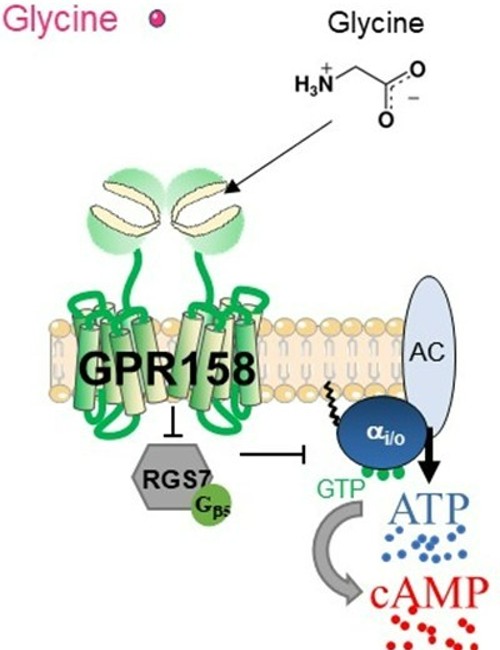Researchers Solve the Puzzle of a Brain Receptor’s Activation
• Research Highlight
G protein-coupled receptors (also called metabotropic receptors) are specific locations on the surface of nerve cells , or neurons, that help cells communicate with each other. These receptors are activated when signaling molecules bind to them. However, for some G protein-coupled receptors, no molecule capable of turning on their signaling function has been identified.
GPR158 is a G protein-coupled receptor highly expressed in the brain, especially in the prefrontal cortex, which is responsible for thought, planning, and emotion and is linked to mental disorders. However, GPR158 is not well understood, and a molecule that activates it had not been identified—until now.
Innovative new research, funded by the National Institute of Mental Health, identified a molecule that binds to the GPR158 receptor and triggers its activity. The study, led by Kirill Martemyanov, Ph.D. , of The Herbert Wertheim UF Scripps Institute for Biomedical Innovation and Technology, showed that GPR158 is activated by glycine, a molecule that is both a neurotransmitter (chemical messenger between neurons) and an amino acid (building block for proteins). The study showed that glycine can increase communication between neurons by interacting with the G protein-coupled receptor.
What did researchers already know about GPR158?
A 2018 study revealed a possible role for GPR158 in mental health by showing that it is present at high levels in the brains of people with depression and in the brains of mice exposed to chronic stress.
In another study , the research team discovered a unique structural feature of the receptor: GPR158 has a domain on its surface, referred to as a Cache domain, that can act as a “docking station” for amino acids. Based on this discovery, the researchers suspected an amino acid might solve the puzzle of GPR158’s activation. But it was unknown which, if any, amino acid binds this unique receptor.
What did this new study reveal about GPR158?
The current study builds on a large body of research by Martemyanov and colleagues examining GPR158. Using the latest genomic technology, the researchers first tested a library of amino acids and found that only glycine impacted GPR158’s cellular signaling.
They then verified that GPR158 is a direct target of glycine by performing a series of experiments fitting glycine into the binding pocket formed by the Cache domain identified in the earlier study. This step confirmed that GPR158 is a receptor for glycine, and glycine activates the receptor specifically by binding to its Cache domain.
Having identified glycine as a molecule capable of turning on GPR158, the researchers applied glycine directly to human cells to see what would happen. In cells expressing GPR158, glycine significantly decreased their cellular signaling. The researchers saw this glycine-induced reduction across multiple cell types—but not if the cells lacked GPR158. The results confirmed that glycine binds to GPR158 and affects cellular signaling.

In another set of experiments, the researchers explored how glycine acts on GPR158 to affect neuronal activity (the firing of nerve cells that allows them to communicate). They found that glycine did not reduce the activity of GPR158 itself. Instead, glycine reduced the actions of a signaling complex associated with the receptor called RGS7-Gβ5 . RGS7-Gβ5 acts as a powerful brake on cellular signaling. Thus, in a real-world example of two negatives making a positive outcome, glycine decreased the activity of the RGS7-Gβ5 complex, which already reduced cellular signaling. As a result, neuronal firing increased.
Last, the researchers used mice to examine how glycine’s effects on GPR158 might impact the activity of neurons in areas of the prefrontal cortex where the receptor is widely expressed. As expected, glycine acting on GPR158 via the RGS7-Gβ5 complex had an excitatory effect on neuronal activity, increasing neurons’ firing. In contrast, glycine did not alter the activity of cortical neurons lacking the receptor.
What did this study reveal about glycine?
The discovery that glycine binds to GPR158 means we better understand how the receptor works. Given GPR158’s newly discovered binding molecule, the researchers have proposed renaming it mGlyR, short for metabotropic glycine receptor.
Not only does this study add to our knowledge of GPR158’s unique properties, but it also reveals important information about glycine. Glycine is considered an inhibitory neurotransmitter, meaning it reduces the ability of neurons to send chemical messages to other cells. In carrying out this inhibitory action, glycine had been thought to bind only to ion channels—sites on the surface of cells that allow charged particles called ions to move in and out of the cell.
The current study upends our understanding of glycine. The finding that glycine binds to a G protein-coupled receptor in GPR158 reveals a new way that glycine acts in the body. Moreover, when glycine binds to the G protein-coupled receptor, it has an excitatory effect that helps neurons send messages to other cells, revealing a new way that neuronal activity is altered in the brain.
Why does this study matter?
This study is highly impactful because it reveals several new findings:
- Glycine is the first (and only) transmitter for GPR158, which did not have an identified signaling molecule until now.
- GPR158 is the first G protein-coupled receptor for glycine, which had previously been shown to bind only to ion channels.
- Glycine has an excitatory effect on the G protein-coupled receptor, which contrasts its inhibitory effect on ion channels.
The findings highlight the importance of GPR158 as a receptor capable of altering activity in an area of the brain important for understanding and treating mental disorders. This discovery presents a potential new target for developing improved treatments for mental disorders like anxiety and depression.
Reference
Laboute, T., Zucca, S., Holcomb, M., Patil, D. N., Garza, C., Wheatley, B. A., Roy, R. N., Forli, S., & Martemyanov, K. A. (2023). Orphan receptor GPR158 serves as a metabotropic glycine receptor: mGlyR. Science, 379(6639), 1352–1358. https://doi.org/10.1126/science.add7150
